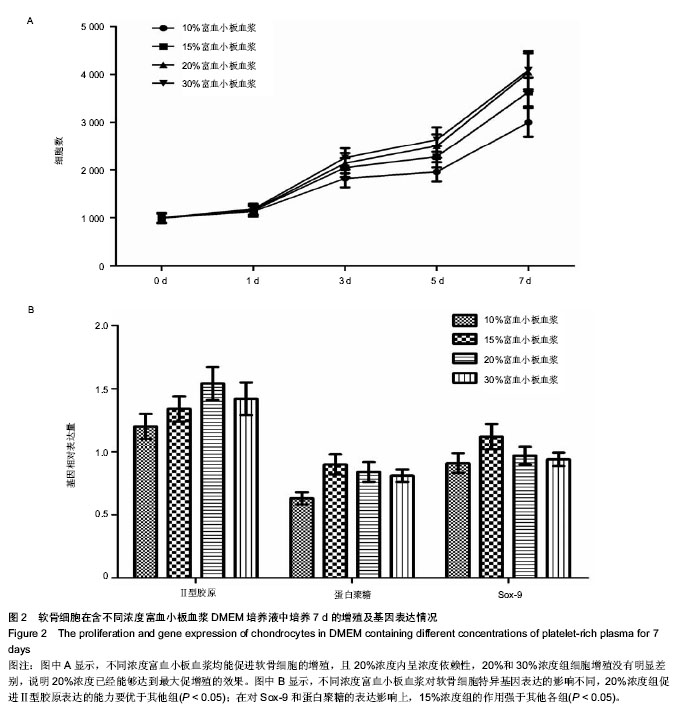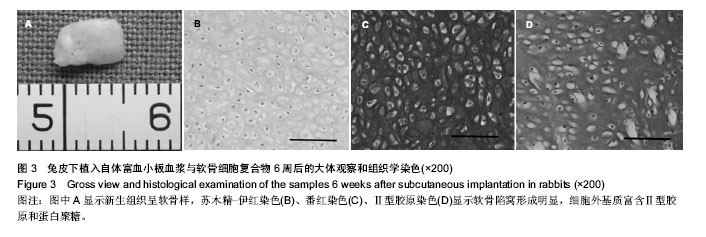| [1] Raub CB,Hsu SC,Chan EF,et al.Microstructural remodeling of articular cartilage following defect repair by osteochondral autograft transfer. Osteoarthritis Cartilage.2013;21:860-868.
[2] Wu J,Xue K,Li H,et al.Improvement of PHBV scaffolds with bioglass for cartilage tissue engineering.PLoS One. 2013;8: e71563.
[3] Filardo G,Kon E,Andriolo L,et al.Clinical Profiling in Cartilage Regeneration: Prognostic Factors for Midterm Results of Matrix-Assisted Autologous Chondrocyte Transplantation.Am J Sports Med.2014.42(4):898-905.
[4] Ko JY,Kim KI,Park S,et al.In vitro chondrogenesis and in vivo repair of osteochondral defect with human induced pluripotent stem cells.Biomaterials.2014;35(11):3571-3581.
[5] Xue K,Qi L,Zhou G,et al.A two-step method of constructing mature cartilage using bone marrow-derived mesenchymal stem cells. Cells Tissues Organs.2013;197:484-495.
[6] Xue K,Zhu Y,Zhang Y,et al.Xenogeneic chondrocytes promote stable subcutaneous chondrogenesis of bone marrow-derived stromal cells.Int J Mol Med.2012;29:146-152.
[7] Levine DW,Roaf PL,Duguay SJ.Characterized chondrocyte implantation results in better structural repair when treating symptomatic cartilage defects of the knee in a randomized controlled trial versus microfracture. Am J Sports Med. 2009; 37:e3; author reply e4.
[8] Saris DB,Vanlauwe J,Victor J,et al.Characterized chondrocyte implantation results in better structural repair when treating symptomatic cartilage defects of the knee in a randomized controlled trial versus microfracture. Am J Sports Med. 2008; 36: 235-246.
[9] Blanke M,Carl HD,Klinger P,et al.Transplanted chondrocytes inhibit endochondral ossification within cartilage repair tissue. Calcif Tissue Int.2009;85:421-433.
[10] Peffers MJ,Liu X,Clegg PD.Transcriptomic signatures in cartilage ageing. Arthritis Res Ther.2013;15:R98.
[11] Li Y,Wei X,Zhou J,et al.The age-related changes in cartilage and osteoarthritis. Biomed Res Int.2013;2013:916530.
[12] Sato M,Shin-ya K,Lee JI,et al.Human telomerase reverse transcriptase and glucose-regulated protein 78 increase the life span of articular chondrocytes and their repair potential. BMC Musculoskelet Disord.2012;13:51.
[13] Cai L,Ye H,Yu F,et al.Effects of Bauhinia championii (Benth.) Benth.polysaccharides on the proliferation and cell cycle of chondrocytes.Mol Med Rep.2013;7:1624-1630.
[14] Li Y,Qin J,Lin B,et al.The effects of insulin-like growth factor-1 and basic fibroblast growth factor on the proliferation of chondrocytes embedded in the collagen gel using an integrated microfluidic device.Tissue Eng Part C Methods. 2012;16:1267-1275.
[15] Jonitz A,Lochner K,Tischer T,et al.TGF-β1 and IGF-1 influence the re-differentiation capacity of human chondrocytes in 3D pellet cultures in relation to different oxygen concentrations.Int J Mol Med.2012;30(6):666-672.
[16] Chen Y,Ke J,Long X,et al.Insulin-like growth factor-1 boosts the developing process of condylar hyperplasia by stimulating chondrocytes proliferation.Osteoarthritis Cartilage. 2012;20: 279-287.
[17] Kim HY,Park JH,Han YS,et al.The effect of platelet-rich plasma on flap survival in random extension of an axial pattern flap in rabbits. Plast Reconstr Surg.2013;132:85-92.
[18] Browning SR,Weiser AM,Woolf N,et al.Platelet-rich plasma increases matrix metalloproteinases in cultures of human synovial fibroblasts.J Bone Joint Surg Am. 2012;94:e1721- 1727.
[19] Yuan T,Guo SC,Han P,et al.Applications of leukocyte- and platelet-rich plasma(L-PRP) in trauma surgery.Curr Pharm Biotechnol.2012;13:1173-1184.
[20] Lenza M,Ferraz Sde B,Viola DC,et al.Platelet-rich plasma for long bone healing. Einstein (Sao Paulo).2013;11:122-127.
[21] Sommeling CE,Heyneman A,Hoeksema H,et al.The use of platelet-rich plasma in plastic surgery: a systematic review.J Plast Reconstr Aesthet Surg.2013;66:301-311.
[22] Marx RE.Platelet-rich plasma: evidence to support its use.J Oral Maxillofac Surg.2004;62:489-496.
[23] Alio JL,Arnalich-Montiel F,Rodriguez AE.The role of "eye platelet rich plasma" (E-PRP) forwound healing in ophthalmology.Curr Pharm Biotechnol.2012;13:1257-1265.
[24] Kruger JP,Freymannx U,Vetterlein S,et al.Bioactive factors in platelet-rich plasma obtained by apheresis.Transfus Med Hemother.2013;40:432-440.
[25] Perdisa F,Filardo G,Di Matteo B,et al.Platelet rich plasma: A valid augmentation for cartilage scaffolds? A systematic review. Histol Histopathol.2014.[Epub ahead of print]
[26] Meretoja VV,Dahlin RL,Wright S,et al.Articular Chondrocyte Redifferentiation in 3D Co-cultures with Mesenchymal Stem Cells.Tissue Eng Part C Methods.2014
[27] Sato M,Yamato M,Hamahashi K,et al.Articular cartilage regeneration using cell sheet technology. Anat Rec (Hoboken).2013;297:36-43.
[28] Eo SH,Cho H,Kim SJ.Resveratrol Inhibits Nitric Oxide-Induced Apoptosis via the NF-Kappa B Pathway in Rabbit Articular Chondrocytes. Biomol Ther (Seoul).2013; 21: 364-370.
[29] Pirvu TN,Schroeder JE,Peroglio M,et al.Platelet-rich plasma induces annulus fibrosus cell proliferation and matrix production. Eur Spine J.2014;23(4):745-753.
[30] Carneiro MD,Barbieri CH,Barbieri JN.Platelet-rich plasma gel promotes regeneration of articular cartilage in knees of sheeps. Acta Ortop Bras.2013;21:80-86.
[31] Arnoczky SP,Shebani-Rad S.The basic science of platelet-rich plasma (PRP): what clinicians need to know. Sports Med Arthrosc.2013;21:180-185.
[32] Ohba S,Wang W,Itoh S,et al.Efficacy of platelet-rich plasma gel and hyaluronan hydrogel as carriers of electrically polarized hydroxyapatite microgranules for accelerating bone formation.J Biomed Mater Res A.2012;100:3167-3176.
[33] Chen W,Sun CC,Chen S,et al.A novel validated enzyme-linked immunosorbent assay to quantify soluble hemojuvelin in mouse serum. Haematologica. 2013;98: 296-304.
[34] Liu D,Cui W,Liu B, et al.Atorvastatin Protects Vascular Smooth Muscle Cells From TGF-beta1-Stimulated Calcification by Inducing Autophagy via Suppression of the beta-Catenin Pathway.Cell Physiol Biochem. 2014;33: 129-141.
[35] Feng ZY,He ZN,Zhang B,et al.Osteoprotegerin promotes the proliferation of chondrocytes and affects the expression of ADAMTS-5 and TIMP-4 through MEK/ERK signaling.Mol Med Rep.2013;8:1669-1679.
[36] Ma WJ,Hashii M,Munesue T,et al.Non-synonymous single-nucleotide variations of the human oxytocin receptor gene and autism spectrum disorders: a case-control study in a Japanese population and functional analysis.Mol Autism. 2013;4:22.
[37] Abd El Kader T,Kubota S,Nishida T,et al.The regenerative effects of CCN2 independent modules on chondrocytes in vitro and osteoarthritis models in vivo. Bone.2014; 59: 180-188.
[38] Scala M,Mereu P,Spagnolo F,et al.The Use of Platelet-rich Plasma Gel in Patients with Mixed Tumour Undergoing Superficial Parotidectomy: A Randomized Study. In Vivo 2014;28(1):121-124.
[39] Moo EK,Han SK,Federico S,et al.Extracellular matrix integrity affects the mechanical behaviour of in-situ chondrocytes under compression.J Biomech.2014.[Epub ahead of print]
[40] Lopa S,Madry H .Bioinspired Scaffolds for Osteochondral Regeneration. Tissue Eng Part A.2014.[Epub ahead of print]
[41] Yang HS,Shin J,Bhang SH,et al.Enhanced skin wound healing by a sustained release of growth factors contained in platelet-rich plasma.Exp Mol Med.2011;43(11):622-629.
[42] Marx RE.Platelet-rich plasma: evidence to support its use. J Oral Maxillofacial Surg.2004;62:489-496.
[43] Eppley BL,Woodell JE,Higgins J. Platelet quantification and growth factor analysis from platelet rich plasma: implications for wound healing. Plast Reconstr Surg. 2004;114(6): 1502-1508.
[44] Akeda K,An HS,Okuma M,et al.Platelet-rich plasma stimulates porcine articular chondrocyte proliferation and matrix biosynthesis.Osteoarthritis Cartilage.2006;14(12): 1272-1280.
[45] Drengk A,Zapf A,Stürmer EK,et al.Influence of platelet-rich plasma on chondrogenic differentiation and proliferation of chondrocytes and mesenchymal stem cells. Cells Tissues Organs.2009;189(5):317-326.
[46] van der Kraan P,Vitters E,van den Berg W.Differential effect of transforming growth factor beta on freshly isolated and cultured articular chondrocytes.J Rheumatol. 1992;19(1): 140-145.
[47] Fortier LA,Nixon AJ,Williams J,et al.Isolation and chondrocytic differentiation of equine bone marrow-derived mesenchymal stem cells.Am J Vet Res.1998; 59(9): 1182-1187.
[48] Park SI,Lee HR,Kim S,et al.Time-sequential modulation in expression of growth factors from platelet-richplasma (PRP) on the chondrocyte cultures.Mol Cell Biochem. 2012;361(1-2): 9-17. |



.jpg)